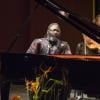
There was nothing George Enescu couldn’t do. The Romanian musician was a Renaissance man: a violin prodigy, a conductor, a composer — oh, and he played piano (with technique Alfred Cortot said was better than his own). Enescu’s Impromptu concertant is the work of a composer just getting started, and this youthful outpouring set the tone for last Tuesday’s Chamber Music San Francisco recital by violinist Daniel Hope and pianist Simon Crawford-Phillips, featuring music of the Belle Époque.
Much of the Impromptu, written while Enescu was studying at the Paris Conservatory, is an elaboration of G-flat major. At Herbst Theatre on April 30, the piano’s chords teased out harmonies from the violin, Hope’s slides caressing every repeated pitch, Crawford-Phillips’s arpeggiations like fountains spilling over from Claude Debussy.
Actually, it was Maurice Ravel who was in the same class at the conservatory — only he was a student of little distinction, and his Violin Sonata No. 1, a single movement published posthumously, doesn’t always convince. It’s only after it plays out that you recognize the theme. Listening to the piece is like dozing: You snap back in after what could have been a minute or an hour.
But the duo made it a shapelier score. Hope’s forceful, passionate playing here made it easy to imagine Enescu performing it, as he likely did — though we only have conclusive evidence of a reading by Paul Oberdoerffer, and that’s a name that means little even to violinists.
Hope’s name, of course, is ubiquitous. He’s made several dozen recordings, including much of the music on Tuesday’s program. He’s a radio and television host, a humanitarian, an author — and he played 185 concerts last year, including several as the leader of San Francisco’s New Century Chamber Orchestra, where he’s served as music director since 2018. And Crawford-Phillips has a busy career not only as a pianist but as a conductor and director.
With these two at the helm, we didn’t end up needing the six songs of Manuel de Falla’s Suite populaire espagnole, added to round out the Ravel. Still, they were a nice bonus, especially when the dances slowed to a saunter in the languorous “Nana” and in “Asturiana,” a haunting movement that anticipates Enescu’s folksy Violin Sonata No. 3.
Beethoven can’t have been a good dancer, but that’s just one way Jake Heggie’s Fantasy Suite 1803 plays against type. The eclectic piece, here in its U.S. premiere, turns over aspects of Beethoven’s life in movements searching and spry. You get the sense that it’s also a personal piece for Heggie. “Everything in my life was connected to Beethoven,” he has said.
With tango-tinged harmonies dislodging the music, it doesn’t feel too literal when the mute comes on in “Toward Silence,” music about Beethoven’s hearing loss. And aside from its quotations of the “Dies irae” sequence, the movement about fate dodges cliche. The notes never come knocking, and there’s no C minor (well, not in this movement). Instead, it’s the nervy rhythms — tango, but make it Michael Tippett — and dryly thrumming piano strings that portend.

César Franck’s Sonata in A Major has its share of extravagant pianism, but particularly when the bass notes make themselves useful do you remember that the composer was a church organist. Hope pulled out all the stops on violin — only this score doesn’t need it. With so much portato and focused vibrato making luxuries out of the little notes, you got little sense of the larger phrases. Ironically, the most substantial piece on the program drooped under the weight of so many embellishments and such strong sound.
Written four years before he died, this sonata is Franck’s masterpiece — to think that it was only a wedding present for the violinist-composer Eugène Ysaÿe. In the last movement’s melody, the players are never exactly in sync, but still, they get a happy ending. Before that it’s naive music, full of wonder. That feeling came through on Tuesday in the third movement’s Recitativo-Fantasia, not in the showy passages but in the first page’s simple chords, whose every harmonic turn is a miracle.




